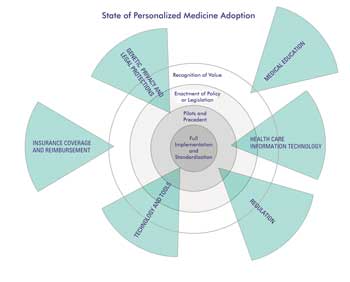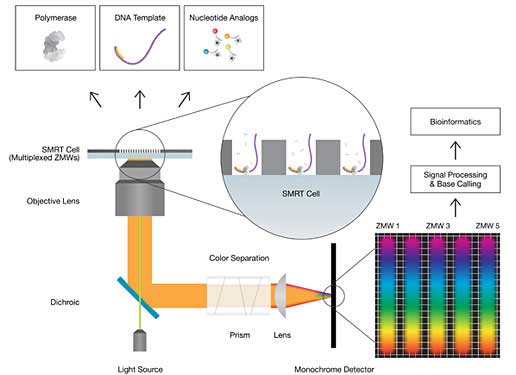
Personalized Medicine: No Longer Ahead of Its Time?
Overcoming hurdles, the personalized approach to care might finally pay off
Personalized medicine – which takes advantage of molecular
imaging, among other technologies, to determine the best course of treatment for
individual patients – is an idea whose time has come. Here, we look at some
of the obstacles companies have faced in trying to develop personalized medicine
for clinical use and at recent developments that could lead to its widespread deployment.
On average, drugs today work in only half
of the people who take them, according to a report by the Personalized Medicine
Coalition. For some patient populations – Alzheimer’s and cancer patients,
in particular – the number is considerably lower. As a result, treatment costs
can soar as doctors move from one drug to the next hoping to find the therapy that
works, often having to address complications and adverse reactions to those that
do not. And while the patient’s medical bills continue to pile up, the psychological
toll – of submitting to endless rounds of tests, of not getting better despite
all of this – can be substantial.
Personalized medicine can help reduce the economic and psychological
costs of receiving care by essentially tailoring the treatment to the patient. Based
on the patient’s genetic profile, doctors can choose the most effective drug
or treatment protocol, contributing to improved outcomes while also minimizing the
possibility of side effects. At the same time, personalized medicine can contribute
to preventive care planning by identifying a patient’s predisposition to a
disease.

The implementation of personalized medicine requires a confluence
of several sectors (represented by wedges in the diagram). Concentric circles and
range represent stages of implementation for each sector, from public or stakeholder
recognition of the value of personalized medicine, the establishment of supporting
policies and laws, the launch and execution of smaller-scale pilot programs and
projects to the final stage of full implementation and widespread use. Full implementation
of personalized medicine can be achieved only when all sectors converge toward the
center. Courtesy of the Personalized Medicine Coalition; originally printed in the
report The Case for Personalized Medicine.
For all its promise, however, it has yet to see widespread clinical
use.
Edward Abrahams is president of the Personalized Medicine Coalition,
which was established in 2004 to educate the public, policymakers, government officials
and private sector health care leaders about the benefits of personalized medicine.
With nearly 200 members today, the coalition serves to provide a better understanding
of the opportunities and challenges in personalized medicine. In a recent e-mail,
Abrahams identified the three most significant hurdles that personalized medicine
encounters: regulation, reimbursement and education.
Health care companies looking to bring new drugs and companion
diagnostic tests to the market face considerable regulatory hurdles. In particular,
the FDA should establish clear, consistent regulations for co-developed and companion
drugs and diagnostics, Abrahams said. Otherwise, “personalized medicine will
not develop as fast as it might.”
Even with FDA approval, therapies can be hampered by their inability
to be reimbursed. Medicare and Medicaid often set reimbursement policies for other
public and private payers. Sometimes they require extraordinarily high levels of
evidence – often beyond the financial ability of small diagnostic companies
– to justify their investment.
Finally, Abrahams said, “an FDA-approved treatment covered
by insurance is not useful to patients unless their health care provider knows about
it. Educating those in clinical practice about available personalized therapies
is critical to widespread adoption of personalized medicine and, therefore, to increasing
efficacy and reducing adverse events.”
(Also, pharmaceuticals have resisted embracing personalized medicine
because they stand to gain more from selling less-targeted drugs designed for broader
patient populations – the so-called “blockbuster” drugs. Targeted
drugs not only would bring in less revenue, but also would likely involve less efficient
marketing campaigns. But even the pharmaceuticals are beginning to acknowledge the
potential benefits of drugs that serve smaller populations more effectively.)

All of this had led to a certain reticence on the part of investors,
an uncertainty as to whether personalized medicine and the companies working to
bring the associated technology to market can really deliver on the promise. But
with advances in the field, new players and a new business model, these attitudes
are beginning to change.
The declining cost of sequencing individual human genomes has
facilitated further research and development (R&D) efforts, leading to new discoveries
and a number of tools with which to develop new targeted therapeutics; for example,
the companion diagnostic tests that companies have begun to develop alongside drugs
early in the R&D process. At the same time, Abrahams said, “more medical
centers across the country have been successful in using personalized treatments
to benefit patients with a wider range of ailments, improving patient outcomes and,
we’d like to believe, lowering costs.”
The emergence of pharmacy benefit managers such as Medco Health
Solutions Inc. and CVS Caremark is further aiding the business case of personalized
medicine. These companies provide personalized medicine services to employers, who
will save money with improved health outcomes among their workers and reduced prescription
costs. Also, they anticipate that the genetic testing they perform will lead to
greater numbers of particular generic drugs, resulting in greater profits.

DNA sequencing is performed on Single Molecule Real Time (SMRT) Cells,
each of which contains thousands of zero-mode waveguides. The cells enable single-molecule,
real-time observation of individual fluorophores against a dense background of labeled
nucleotides while maintaining a high signal-to-noise ratio. Courtesy of Pacific
Biosciences.
Mohr Davidow Ventures of Menlo Park, Calif., is among those companies
that believe personalized medicine’s time has come. “Personalized medicine
is happening,” Bill Ericson, managing partner at Mohr Davidow, told The Boston
Globe in July. “The thesis is sound. It takes years to develop these products.”
The early-stage venture capital firm is funding a number of entrepreneurs and cross-disciplinary
research teams working in this area, including Pacific Biosciences, also of Menlo
Park.
In July, Pacific Biosciences, which has developed a disruptive
technology platform for the real-time detection of biological events at single-molecule
resolution, announced that it had completed a Series F round of financing in the
amount of $109 million. To date, the company has raised $370 million in capital
to support development of its Single Molecule Real Time (SMRT) DNA sequencing technology.

Pacific Biosciences of Menlo Park, Calif., is developing DNA sequencing
technology that could enable more precise diagnostics and thus contribute to personalized
medicine applications. Shown is a schematic of the underlying technology of the
Pac Bio DNA sequencing platform. ZMW = zero-mode waveguide. Courtesy of Pacific
Biosciences.
The financing round includes a previously announced $50 million
strategic investment by Gen-Probe Inc. of San Diego. Besides this, Pacific Biosciences
will work with Gen-Probe to develop integrated clinical diagnostics systems, taking
advantage of the SMRT platform and Gen-Probe’s expertise in diagnostics.
“We see a significant opportunity for our SMRT platform
in the molecular diagnostics market and are taking a proactive and strategic approach
by collaborating with Gen-Probe, a proven leader in developing fully automated instrument
systems for nucleic acid testing,” said Hugh Martin, chairman and chief executive
officer of Pacific Biosciences. “We believe Gen-Probe’s expertise in
instrument systems engineering and sample preparation, combined with their capabilities
in clinical and regulatory affairs, will help us maximize the potential of our sequencing
technology to benefit human health.”
Published: September 2010